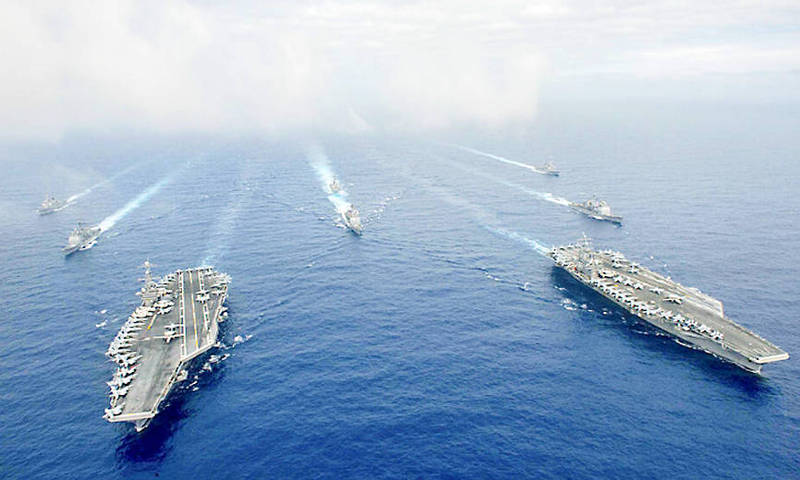《TAIPEI TIMES》 US increasing multinational exercises in Pacific

The Nimitz-class aircraft carriers USS John C. Stennis, left, and USS Ronald Reagan conduct dual aircraft carrier strike group maneuvers in the US Seventh Fleet’s area of operations in the Philippine Sea on June 18, 2016. Photo: Jake Greenberg / US Navy / Handout via Reuters
PARTNERING UP: More frequent exercises with larger vessels in joint flotillas of like-minded countries would help ward off Chinese aggression, a former US official said
By Liu Tzu-hsuan / Staff reporter
US forces in the Pacific are increasing multinational military exercises in response to growing concerns about China’s aggression in the region, US Seventh Fleet Commander Vice Admiral Karl Thomas told the Washington Times.
To counter Beijing’s ambition of assuming greater control over the region, the US is focusing on “being forward and having many nations working together,” Thomas said in an interview published on Friday.
Based in Japan, the US Navy’s largest fleet is conducting more and larger exercises with more like-minded allies and partners, he said.
The fleet — which includes 50 to 70 ships and submarines, 150 aircraft and more than 27,000 sailors and marines — has conducted more than 37 military drills in a region that stretches from the Northern Territories in Japan and the Russian-held Southern Kuriles, west to the Indian Ocean and south to Antarctica, the article said.
In addition to the US Navy, the US Marine Corps, US Army and US Air Force have carried out more operations with allied countries, including joint patrols in the disputed South China Sea and East China Sea with French and Canadian warships, it said.
The Australian Army, for the first time as a full partner after 10 years of observation, joined the US Army and the Japan Ground Self-Defense Force in the annual Yama Sakura military exercise earlier this month, the US Indo-Pacific Command said.
The exercise enabled the alliance to enhance its deterrence and response capabilities in the region by building interoperability, it said.
More countries in the region — including Indonesia, Malaysia, Sri Lanka and island nations in the Pacific — are “rejecting neutrality and choosing to work more closely with the US,” rather than keeping their distance from the tensions between Washington and Beijing, the Washington Times said.
The increase in military drills reflects “a new US reassurance of allies worried about China,” it said.
Miles Yu (余茂春), director of the China Center at the Hudson Institute and a former adviser on China policy to the US Department of State, told the newspaper that more operations are needed to ward off Chinese maritime aggression.
“It is essential we continue and strengthen our exercises and operations in international commons such as the South China Sea and the Taiwan Strait, and do it multilaterally, more frequently, with bigger vessels and joint flotillas of navies of like-minded countries, including NATO allies, but especially the primary victims of China’s relentless maritime bullying and harassment in the region,” Yu said.
Regarding recent conflicts between China and the Philippines at the Second Thomas Shoal (Renai Shoal, 仁愛暗沙), Thomas said that China is ramping up its “gray zone” tactics to seek illegal control over the Spratly Islands (Nansha Islands, 南沙群島), of which the shoal is a part and is also claimed by Taiwan.
Chinese behavior “causes all of us [nations in the region] concern, and we’re watching very closely,” he said.
Chinese state media have criticized the increase in military exercises by the US and its partners, which US officials say might be an indication that “Beijing is getting the strategic message,” the Washington Times report said.
新聞來源:TAIPEI TIMES


















